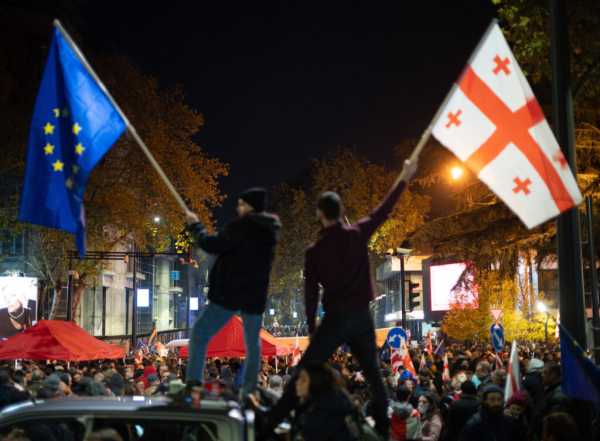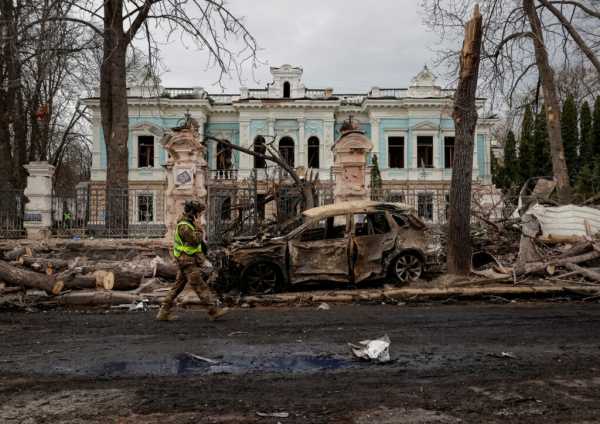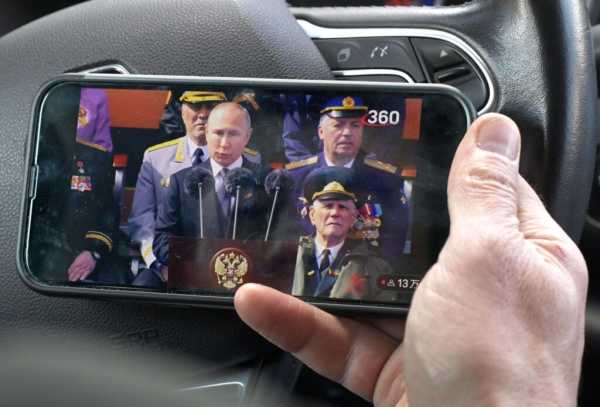The mission in Germany would streamline a training and assistance system that the United States and its allies created on the fly after Russia’s invasion, officials said.
-
Send any friend a story
As a subscriber, you have “>10 gift articles to give each month. Anyone can read what you share.
Give this articleGive this articleGive this article

Ukrainian soldiers heading toward the front line near Kramatorsk, in the country’s east, in May. The Pentagon’s proposal for a new command signals that the United States expects the threat from Russia to persist for many years, current and former senior U.S. officials said.
WASHINGTON — The Pentagon is preparing to overhaul how the United States and its allies train and equip the Ukrainian military, reflecting what officials say is the Biden administration’s long-term commitment to support Ukraine in its war with Russia.
The proposal would streamline a training and assistance system that was created on the fly after the Russian invasion in February. The system would be placed under a single new command based in Germany that would be led by a high-ranking U.S. general, according to several military and administration officials.
Gen. Christopher G. Cavoli, the top American officer in Europe, recently presented a proposal outlining the changes to Defense Secretary Lloyd J. Austin III, the officials said. Mr. Austin and his top aides are reviewing the plan and are likely to make a final decision in the coming weeks, senior U.S. officials said, adding that the White House and the Pentagon favored the approach. The officials spoke on the condition of anonymity to describe confidential discussions.
Just as the Pentagon has committed more than $16 billion in military aid to Ukraine — a combination of immediate shipments from stockpiles as well as contracts for weapons to be delivered over the next three years — the new command signals that the United States expects the threat from Russia to Ukraine and its neighbors to persist for many years, current and former senior U.S. officials said.
“This recognizes the reality of the important mission of security assistance to our Ukrainian partners,” said Adm. James G. Stavridis, a former supreme allied commander for Europe. “This will also create a formal security structure that our allies and partners can adhere to in terms of getting their equipment and training into the hands of the Ukrainians.”
Gen. David H. Petraeus, a former top U.S. commander in Iraq and Afghanistan, concurred. “This would be a very important and very appropriate initiative,” he said, “given the magnitude of the U.S. effort and the contributions of our NATO allies.”
The new command, which would report to General Cavoli, would carry out the decisions made by the Ukraine Defense Contact Group, a coalition of 40 countries that the Defense Department created after the Russian invasion to address Ukraine's needs and requests. Senior military officials from the member nations met in Brussels this week.
More on U.S. Armed Forces
- A Culture of Brutality: The Navy SEALs’ punishing selection course has come under new scrutiny after a sailor’s death exposed illicit drug use and other problems.
- Sexual Abuse: Pentagon officials acknowledged that they had failed to adequately supervise the Junior Reserve Officers’ Training Corps, after dozens of military veterans who taught in U.S. high schools were accused of sexually abusing their students.
- Civilian Harm: Following reports of civilian deaths from U.S. airstrikes, the Pentagon announced changes aimed at reducing risks to noncombatants in its military operations.
- Space Force: The fledgling military branch, which has frequently been the butt of jokes, dropped an official song extolling the force’s celestial mission. Some public reactions were scathing.
About 300 people would be dedicated to the mission, which would be in Wiesbaden, Germany, the U.S. Army’s headquarters in Europe. Much of the training of Ukrainian soldiers on U.S. weapons systems is already taking place there or nearby.
The changes, which aim to give a formal structure to what has been improvised since the war’s onset, are roughly modeled on U.S. train-and-assist efforts in Iraq and Afghanistan over the past two decades.
The proposal originated this year with Gen. Tod D. Wolters, General Cavoli’s predecessor, and was fine-tuned after General Cavoli took command in July.
Lt. Gen. Christopher T. Donahue, who commanded the U.S. evacuation from Afghanistan in August 2021, has coordinated much of the U.S. military assistance to Ukraine from behind the scenes over the past several months.
From his forward headquarters in Wiesbaden, General Donahue, a former commander of the 82nd Airborne Division who now leads the Army’s 18th Airborne Corps, has helped oversee training, talking to Ukrainian generals about their battlefield needs and drawing on his Special Operations background to advise his Ukrainian counterparts.
But General Donahue and his command staff, who have been deployed to Poland and Germany since the early days of the war, are scheduled to return to their main headquarters at Fort Bragg, N.C., in the next month, Defense Department officials said.
What we consider before using anonymous sources. Do the sources know the information? What’s their motivation for telling us? Have they proved reliable in the past? Can we corroborate the information? Even with these questions satisfied, The Times uses anonymous sources as a last resort. The reporter and at least one editor know the identity of the source.
Learn more about our process.
So the Pentagon would need someone else to lead the more formal command structure.
Brig. Gen. Patrick S. Ryder, the Pentagon press secretary, declined to discuss the proposal but added in an email, “We are continuously assessing and refining our internal posture and processes to ensure we provide Ukraine with timely, relevant security assistance to meet its most urgent needs on the battlefield and to build its enduring strength to deter future Russian aggression.”
U.S. officials have not publicly discussed the proposal, partly because Pentagon officials are still sorting through the plan but also to avoid feeding into the narrative of President Vladimir V. Putin of Russia that his country is at war with the United States and NATO, not Ukraine.
Still, the Pentagon has taken steps to begin the expected consolidation of the train-and-equip duties. Over the summer, a cell of logistics specialists that matches Ukraine’s requests with military donations from more than 40 nations moved to Wiesbaden from Stuttgart, Germany.
The little-known group — formally called the International Donor Coordination Center, along with officers from more than two dozen countries — is playing a pivotal role in supporting Ukraine’s military as its battlefield needs become more complicated.
The Pentagon said on Wednesday that it would send an additional $1.1 billion in long-term military aid to Ukraine, including 18 High Mobility Artillery Rocket System launchers, or HIMARS. But unlike the 16 HIMARS the military rushed to Ukraine from its stockpiles over the summer, these new weapons will be ordered from the manufacturer, Lockheed Martin, and will take “a few years” to deliver, a senior Defense Department official told reporters.
Ukrainian and American officials say the now weekly or biweekly Pentagon announcements of new shipments of weapons and munitions from U.S. inventories have given Kyiv’s senior commanders the confidence to plan complex simultaneous offensives, like those in the Kherson region in the south and in Kharkiv in the northeast.
Ukrainian soldiers are temporarily pulled off the battlefield to learn how to operate American and other Western weapons systems. About 2,000 Ukrainians have been trained so far on U.S. artillery and drones, according to Pentagon officials.
Wiesbaden would be the locus of U.S.-led training and assistance, but other Western countries are training Ukrainian soldiers elsewhere. Britain, for instance, started a program over the summer to train as many as 10,000 Ukrainian recruits in weaponry, patrol tactics, first aid and other skills at British bases. Denmark announced this month that it would begin a similar program for Ukrainian recruits.
Soon after Russia’s first invasion of eastern Ukraine in 2014, the United States and several other Western countries established training centers in western Ukraine. Special Operations forces trained thousands of Ukrainians before the latest conflict ended the instructions.
With no U.S. troops currently in Ukraine, providing support by phone or computer has been challenging, American officers say.
“It is much more difficult now to communicate with our allies and partners,” Maj. Gen. Steven G. Edwards, the head of U.S. Special Operations forces in Europe, said at a security forum this month. “Teleconference is good, but it’s not nearly the same as what we had before.”
The proposed command would oversee formal instruction at training ranges in Germany as well as technical support centers that have been set up in neighboring countries.
A 50-member military repair team at a base in Poland, for instance, has been providing technical assistance to Ukrainian soldiers on how to fix damaged U.S.-provided arms, including M777 howitzers. Ukrainian manufacturers have taken the additional step of figuring out how to reverse-engineer spare parts.
Since the program began in June, more than a dozen teleconference channels have been set up with over 100 Ukrainian contacts, military officials said.
“This is the proverbial David and Goliath scenario, right?” Command Master Chief Peter C. Musselman, the senior enlisted Special Operations soldier in Europe, said at the security forum. “And David is holding his own pretty good right now.”
Source: nytimes.com



